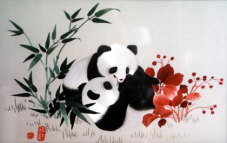
China Overview
- Population: 1.3 billion
- Currency: yuan
- Guinness World Records: most people painting each other's faces simultaneously in one location (13,413), largest bottle of cooking oil (containing 3212 litres), most couples hugging (3009 couples).
- Internet users: 135 million
- Milk beer: from Inner Mongolia, an alternative to the traditional mare's-milk wine.
- Squirrel fish: whole mandarin fish deep-fried and manipulated to resemble a squirrel.
- Number of chinese characters: over 56,000
Silk
 | China is recognised worldwide as "the Nation of Silk". About 6000 years ago the ancient Chinese started raising silkworms for the production of silk. A silkworm can only produce a certain amount of silk---1000 meters (3280feet) during its whole lifetime (no more than 28 days). So it becomes a symbol in Chinese culture of hard work. A poem of Tang Dynasty describes the property of the silkworm accurately: "A silkworm spins all its silk till its death and a candle won't stop its tears until it is fully burnt." |
| Who developed the silk production? It was our ancestors who first developed the silk fabric. According to the Chinese legend, Lei Zu(嫘祖), wife of the Yellow Emperor, discovered silk and invented the silk loom in the 27th century BC. She taught people how to raise silkworms and how to extract the silk. |
|
| Silk, indeed, rapidly became one of the principal elements of the Chinese economy. During the Han Dynasty, the silk production developed rapidly. Many manufactured goods were transported from the then capital city Chang’an (today’s Xi’an) to other countries. This overland trade route was called "Silk Road". At the same time, there was also a “Marine Silk Road”. And so, the silk connected China to the rest of the world. However, the Marine Silk Road became much more important than the Land Silk Road in the Song Dynasty and fully developed in the Yuan Dynasty, because the ruler extended the trade to Southeast Asia in particular. Besides Chinese exports, foreign businessmen also came to China to buy silk and china wares. In both Ming and Qing Dynasties silk was transported to Europe and America. From then on China dominated the world's silk market. | |
 | Where is silk mainly produced in China? |
| The three top brocades are Sichuan Shu, Suzhou Song, and Nanjing Yun. There is also a National Silk Museum in Hangzhou. It is the largest silk museum in the world. Visitors can learn about the origin, evolution and technique of silk production. It has a section devoted to the Silk Road and shows the value of its importance in commerce. | |
| How to choose real and qualified silk? |
| The 100 percent silk items cost much more than the imitation ones. So people who want to buy silk should first of all be aware of the price first. Second, lustre is another guideline feature to show whether a fabric is real or imitation. The 100-percent silk is made with one colour for the warp and one colour for the weft. This is what gives silk its natural sheen and lustre. Thus, when you hold a piece of 100-percent silk up to the light the whole colour tone will change depending on the angle of light. With the imitation, regardless of what angle you hold it in the light, it shines white. Third, the shopper must notice the different weave between the real silk and the imitation. The real silk weave is completely handmade of a natural fibre and we can see clearly small flaws or joins in the thread along the warp and the weft. The imitation one, on the other hand, is a machine-made fabric and has a perfect surface without any flaws or bumps. This aspect can be the most important element for the shopper to find out which is the real silk. |
How to take care of silk products? Silk will fade upon with repeated exposure to the sun. So do not choose silk fabrics for curtains and draperies. |
|
| In order to avoid the direct sunlight, the dyed silk product should be put in a cool dry place. It is not good to wring it after washing. If you want to iron the silk, the temperature of the iron should not be too high. To maintain the silk well, put it in cotton pillowcases or surround them with breathable fabrics, since moths can attack silks. Direct sunlight should also be avoided. What’s more, don’t put it in plastic since this can trap moisture, which can make the silk yellow or mildew. | |
All Topics about China
- General-China-Introduction
- C2-Chinese-History
- Chinese-Religions
- Chinese-Food-and-Drink
- Chinese-Literature
- Chinese-Nationality
- Chinese-Architecture
- Chinese-Arts-and-Crafts
- Chinese-Language-and-Education
- Chinese-Medicine
- Chinese-Transportation
- Chinese-Festival
- Chinese-Astrology-and-Zodiac
- Chinese-Calendar
- Chinese-Traditional-Sports-&-Activities
- Chinese-Martial-Arts
HOTMost Popular Topics
Climate in China
Because of its size, China has great climatic diversity. Generally, the best time to visit China is during spring and autumn.
Chinese-Language-and-Education
Chinese is the most commonly used language in China, and one of the most commonly used languages in the world.
Chinese-Festival
China has many traditional festivals, including the Spring Festival, the Lantern Festival, the Dragon Boat Festival.
Chinese Chinese-Astrology-and-Zodiac
In the Chinese zodiac, twelve animals are used to denote the year of a person's birth: rat, ox, tiger, rabbit, dragon.
History of China
China, one of the world's most ancient civilizations, has a recorded history of nearly 4,000 years..









